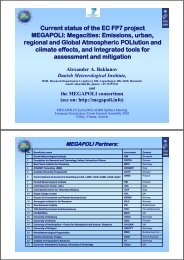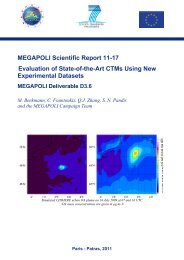D E S C R I P T I O N O F W O R K - MEGAPOLI - Dmi
D E S C R I P T I O N O F W O R K - MEGAPOLI - Dmi
D E S C R I P T I O N O F W O R K - MEGAPOLI - Dmi
Create successful ePaper yourself
Turn your PDF publications into a flip-book with our unique Google optimized e-Paper software.
<strong>MEGAPOLI</strong> 212520<br />
used in a variety of research and technology problems involving physicochemical phenomena. ICE-HT is in<br />
close cooperation with the Department of Chemical Engineering in the University of Patras. The work in this<br />
project will be performed by the Air Quality Laboratory of ICE-HT. This team has approximately 20 years<br />
of experience in the study of urban, regional, and global air quality. Research in the area of sources,<br />
properties, chemistry, and removal of atmospheric aerosol is the major focus of the group. The team is<br />
currently participating in the EUCAARI project.<br />
Role and contribution<br />
FORTH will co-coordinate the project and will participate in WP 3, 4, 6 and 7 providing continuous<br />
measurements of the aerosol size/composition distribution and properties, and continuing the development<br />
and application of state-of-the-art Chemical Transport Models in urban, regional and global scales.<br />
Principal personnel involved<br />
Prof. Spyros Pandis - Director of the Air Quality Laboratory in FORTH, Prof. in the University of Patras in<br />
Greece and the Elias Res. Prof. in Carnegie Mellon University (CMU, US). He has been PI for the Pittsburgh<br />
Supersite (one of the six Centres of Excellence for Atmospheric Aerosols funded by the US EPA) and the<br />
Pittsburgh Air Quality Study (funded by the US DoE) and more than ten additional projects funded by the<br />
US EPA, US NSF, US DoE, etc. He is the author of approximately 120 peer-reviewed papers (3 in Science<br />
and Nature), the vice-president of the American Association for Aerosol Research (AAAR), and the recipient<br />
of Whitby Award of AAAR, the Vaughn Lectureship by Caltech, and the Kun Li, Teare and Tallman Ladd<br />
awards by CMU.<br />
Recent and relevant publications<br />
Seinfeld J. H., Pandis S. N. (2006): Atmospheric Chemistry and Physics: From Air Pollution to Climate Change, 2 nd<br />
edition, J. Wiley, New York.<br />
Gaydos T. M., R. Pinder, B. Koo, K. M. Fahey, G. Yarwood, S. N. Pandis (2006): Development and application of a<br />
three-dimensional aerosol chemical transport model, PMCAMx, Atmos. Environ.,<br />
doi:10.1016/j.atmosenv.2006.11.034.<br />
Dawson J. P., P. J. Adams, S. N. Pandis (2007): Sensitivity of ozone to summertime climate in the eastern US: A<br />
modelling case study, Atmos. Environ., In Press.<br />
Lane T. E., R. W. Pinder, M. Shrivastava, A. L. Robinson, S. N. Pandis (2007): Source contributions to primary<br />
organic aerosol: Comparison of the results of a source-resolved model and the Chemical Mass balance approach,<br />
Atmos. Environ., doi:10.1016/j.atmosenv.2007.01.006.<br />
Robinson A. L., N. M. Donahue, M. K. Shrivastava, E. A. Wietkamp, A. M. Sage, A. P. Grieshop, T. E. Lane, S. N.<br />
Pandis, J. R. Pierce (2007): Rethinking organic aerosols: Semivolatile emissions and photochemical aging,<br />
Science, 315, 1259-1262.<br />
Partner 3 (co-cord.): Max Planck Institute for Chemistry (MPIC)<br />
Expertise and experience of the organization<br />
The Max Planck Institute for Chemistry was established in Mainz in 1949, and focuses on the chemistry of<br />
the atmosphere, particle chemistry, biogeochemistry, remote sensing for Earth systems sciences, and<br />
chemistry of the geosphere. Prof. Jos Lelieveld leads the atmospheric chemistry department. The modelling<br />
group, led by Dr. Mark Lawrence, has many years of experience in global tropospheric, stratospheric, and<br />
mesospheric chemistry modelling, chemistry-climate coupling, support and analysis of field campaigns, and<br />
satellite data analysis.<br />
Role and contribution<br />
MPIC will co-coordinate the project and will participate in WP 1, 5, 6 and 8, providing global model<br />
simulations of the impacts of megacities on atmospheric composition and climate, collaborating on the<br />
development of emissions datasets for sensitivity and scenario studies, and on the interpretation of scenario<br />
runs for evaluating mitigation strategies, as well as working actively towards the dissemination of the results<br />
to the scientific community and stakeholders (public and policy makers).<br />
Principal personnel involved<br />
Dr. Mark Lawrence, who will act as the PI for <strong>MEGAPOLI</strong>, received his Ph.D. in Earth and Atmospheric<br />
Sciences in 1996 from the Georgia Institute of Technology (main thesis advisor: Prof. Paul J. Crutzen). From<br />
2000-2005 he led an independent junior research group at the MPIC, funded by the German Ministry<br />
(BMBF), which focused on modelling studies of tropical tropospheric photochemistry. Since 2006 he has led<br />
the modelling group of the Department of Atmospheric Chemistry. Dr. Lawrence has several years of<br />
experience in the development of photochemical models, being one of the co-developers of the Model of<br />
Atmospheric Transport and Chemistry (MATCH), and has also been involved in using models to plan and<br />
analyze field campaigns. He has over 80 (co)authored publications, including a couple recent papers on<br />
68




